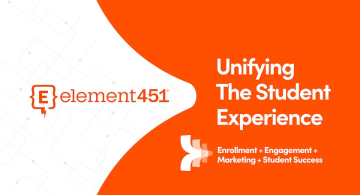Top Strategies To Increase Enrollment In Private Schools
by Brandon Hurter · Updated Nov 28, 2024

Many colleges and universities are still rebounding from the challenges faced during a global pandemic. Both public and private institutions have weathered dips in student enrollment while attempting to deliver strong academic programs in new and tech-savvy environments.
Private schools, which are often more expensive and exclusive than state or public schools, face a unique set of challenges to increase student enrollment. Although the popularity of private schools is still high, campus leaders must be ready to think outside the box in order to recruit more students in the years to come.
In this article, we’ll take a close look at the current trends in college enrollment and discuss effective and practical strategies for increasing private school enrollment. We’ll also share how a student engagement CRM can help a school stand strong in light of changing trends.
Strategies To Increase Enrollment In Private Schools
Increasing student enrollment at private colleges and universities requires practice and experimentation. Private schools may experience seasons of increased demand and periods when enrollment dips. This is normal, and often due to factors that are outside the realm of higher education.
It is possible, however, to be prepared for these seasons with strategies that work to boost enrollment. We’ve chosen six strategies that you can use at any point to strengthen and increase enrollment.
Optimize Your Marketing Efforts
Marketing is the backbone of student recruitment, and private schools must embrace modern tools to stand out. Platforms like Instagram, TikTok, and Snapchat allow schools to share authentic glimpses of campus life, creating connections with prospective students. For example, a short TikTok showcasing a student ambassador’s daily routine can humanize your institution and make it more relatable. Coupled with search engine optimization (SEO) and email campaigns, these efforts ensure your school reaches families actively exploring private school options.
Recruit Beyond the Student
A student’s enrollment decision is often influenced by the people closest to them—parents, guardians, and educators. Private schools must tailor their outreach to include these key stakeholders. Personalized communication, like emails that highlight family-friendly campus initiatives or webinars for high school counselors, ensures the broader support network sees your school’s value. By engaging with families and educators directly, you create advocates who can champion your school to prospective students.
Build an Enticing Private School Brand
A strong brand builds trust and makes your school memorable. This doesn’t just mean having a great logo—it’s about conveying a cohesive identity across every touchpoint. From your website and brochures to social media and community presence, everything should communicate your school’s mission and values. A private school with a clear and modern identity is more likely to attract students who resonate with its message, setting it apart from competitors.
Build Strong Community Engagement
Community involvement enhances your school’s reputation and visibility. Hosting open houses, partnering with local organizations, or participating in community service projects creates opportunities to showcase your school’s culture and values. For example, a community cleanup day that involves students and staff highlights your commitment to service and builds goodwill with local families. Engaging with your community establishes your school as a trusted and valuable institution.
Be Aware of the Competition
It’s no secret that the higher education market is crowded with many valuable, key players. Not only do schools need an in-depth understanding of direct competition (other private schools), but recruiters must also acknowledge the pull of large state institutions and public colleges.
In today’s higher ed environment, private schools must realize and capitalize on their unique selling proposition (USP). A USP clearly spells out the value that students stand to gain from attending.
Whether this involves a prestigious sports program, highly rated internship opportunities, or access to world-renowned faculty, private school recruiters must make these competitive advantages more prominent as a way to meet enrollment goals.
Leverage Personalization Techniques in the Enrollment Strategy
Nurturing each prospective student with personalized messages is another way that private colleges can stand out from the pack. Future students are bound to receive numerous messages, emails, calls, and texts from possible schools. A personalized approach incorporates known data to deliver targeted messages based on what a student needs and wants.
A modern student engagement CRM can also help private schools store student data and use it to better personalize messages later on.
Provide Relevant Resources
To increase enrollment, private schools need to be able to deliver exceptional information and resources. This helps reduce confusion and make the enrollment process easier and more valuable. Connect students to resources that can help them learn more about:
- Financial aid options or scholarship programs
- Extracurricular activities, student life, and exciting events
- Academic support (outside of classroom resources)
- Online flexibility
- Mental health support and counseling resources
- Professional or job-related opportunities
To successfully increase enrollment, all schools must deliver proven value. By reminding students what you have to offer, you can better accomplish this crucial goal.
Measure and Adjust Your Strategies
No strategy is complete without evaluation. Continuously monitor metrics like application rates and engagement levels to understand what’s working and where improvements are needed. Gather feedback from students and families through surveys or follow-ups after events, and use this data to refine your approach. For instance, if open house attendance is low, consider adjusting your promotional methods or event timing to better align with your audience's needs.
How To Implement Enrollment Strategies Effectively
Effective enrollment strategies require a balance of planning, execution, and adaptability. Start by clearly defining your goals—whether it’s boosting application rates, improving yield, or increasing diversity—and aligning your teams to work toward those objectives. Cross-department collaboration is crucial; for example, marketing, admissions, and financial aid teams should share data to create cohesive messaging and ensure prospective students receive timely support.
Leverage technology to streamline processes and enhance communication. A student engagement CRM, like Element451, can automate repetitive tasks such as sending reminders for incomplete applications while personalizing outreach based on student interests. Regularly evaluate the success of your strategies by analyzing metrics such as application completions, event attendance, and engagement rates. Use this feedback to refine your approach, ensuring it remains effective and student-focused.
Challenges Schools Face In Boosting Enrollment
Private schools face several hurdles in today’s competitive education landscape. High tuition costs are a major barrier, making it critical to communicate the value of your institution and highlight financial aid options effectively. Additionally, competition from public schools, which often offer lower tuition and broader accessibility, necessitates a focus on what sets private schools apart, such as small class sizes, specialized programs, or superior student outcomes.
Changing student priorities also pose challenges, with many families now valuing mental health resources, flexible learning options, and clear career pathways. Addressing these expectations through targeted marketing and enhanced campus services can help bridge the gap. Finally, adapting to technological advancements, like hybrid learning models, is essential for staying relevant and appealing to tech-savvy students.
Use Element451 To Boost Your Enrollment Process
For private colleges and universities looking to increase school enrollment and recruitment processes, personalization matters. Making the student the focal point of the journey can help schools find, attract, and recruit the right student candidates. This is particularly important in a highly competitive and crowded education marketplace.
Frequently Asked Questions (FAQs):
What are the most effective digital marketing tools for private schools?
Social media platforms like Instagram and TikTok, email marketing software, SEO tools, and CRMs like Element451 are powerful tools. They help schools reach prospective students, engage families, and personalize communication throughout the enrollment process.
What trends in education should private schools consider to stay competitive?
Key trends include offering hybrid and online learning options, prioritizing mental health support, adopting data-driven recruitment strategies, and providing flexible enrollment pathways. Staying ahead of these trends can enhance your school’s appeal and ensure long-term success.

About Element451
Boost enrollment, improve engagement, and support students with an AI workforce built for higher ed. Element451 makes personalization scalable and success repeatable.
Categories
New Blog Posts

The Definitive Guide
AI in Higher Education
Bridge the gap between the latest tech advancements and your institution's success.
Useful Links
Related Articles

Talk With Us
Element451 is the only AI Workforce Platform for higher education. Our friendly experts are here to help you explore how Element451 can improve outcomes for your school.
Get a Demo








